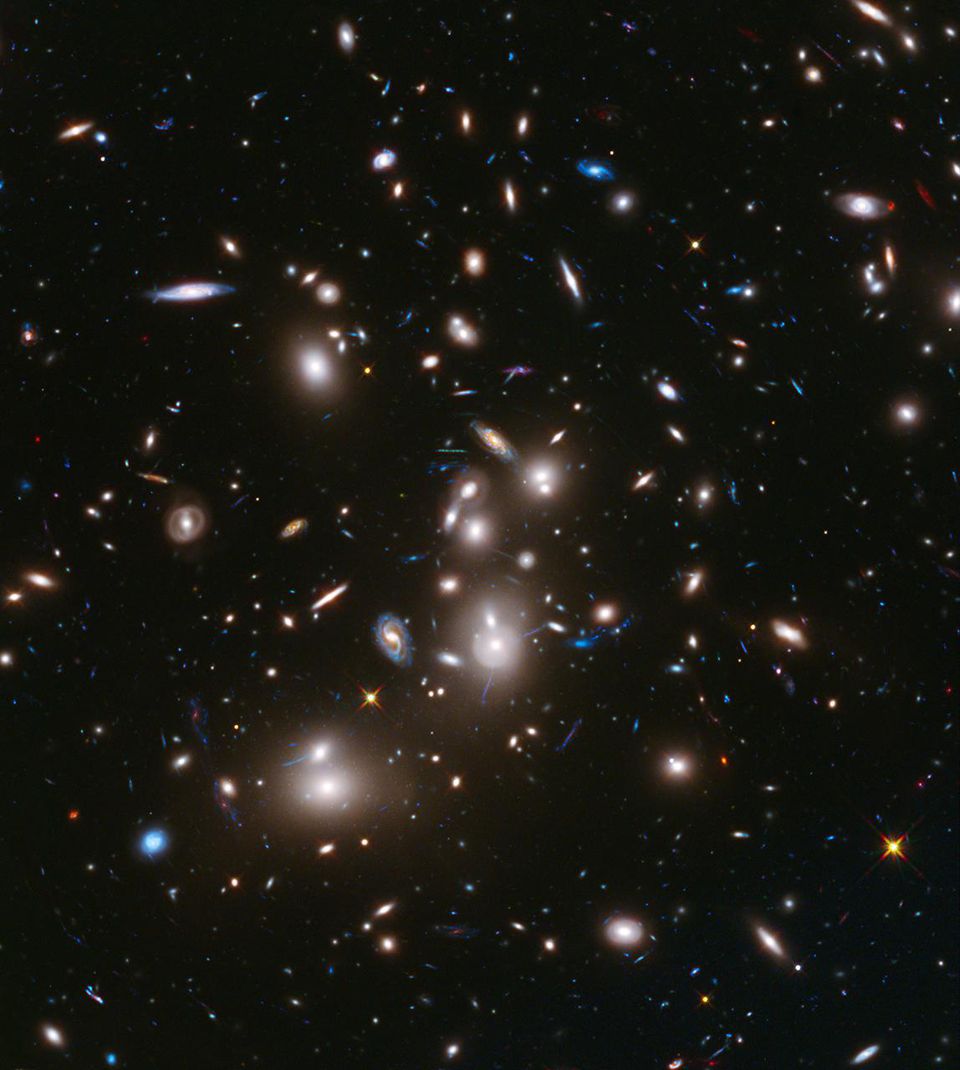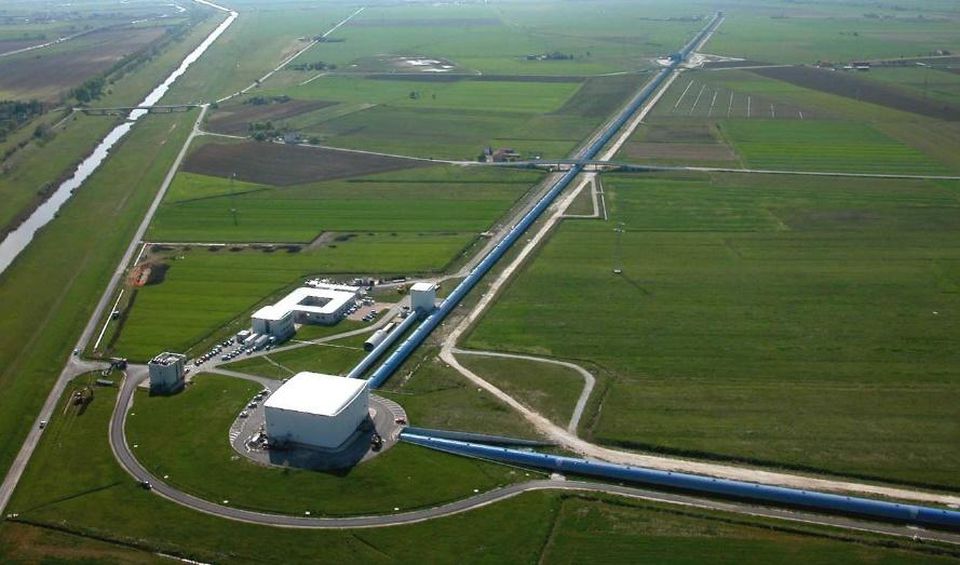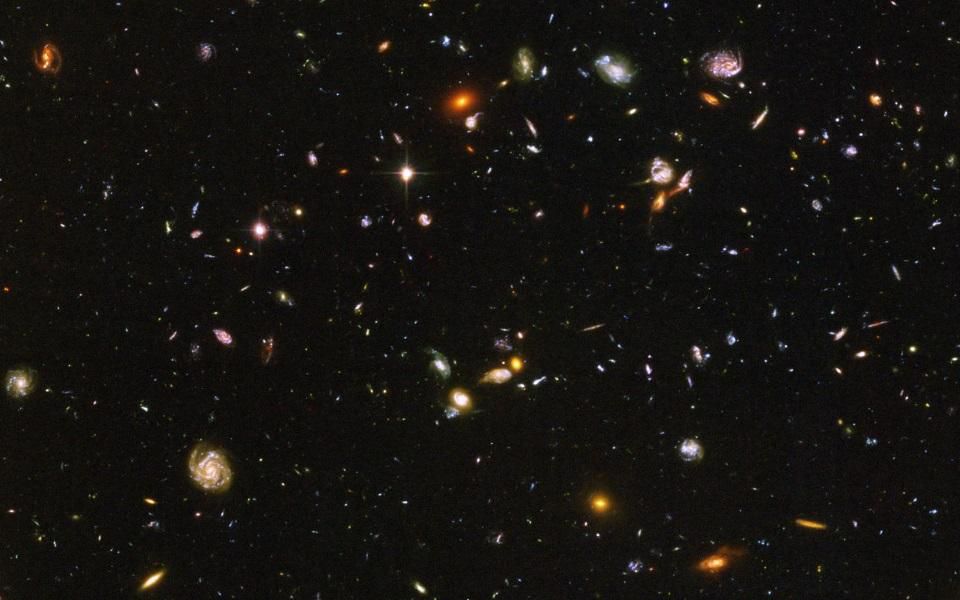 An image of three of the four known exoplanets orbiting HR 8799 , from 2010, represents the first time that such a small telescope - smaller than an adult - could see the exoplanet directly.
An image of three of the four known exoplanets orbiting HR 8799 , from 2010, represents the first time that such a small telescope - smaller than an adult - could see the exoplanet directly.If you had gone to the past for only 30 years, then you would have appeared a completely different world than today. We knew only the planets in our solar system; we had no concept of dark energy; there were no space telescopes; gravitational waves were simply untested theory. We did not discover all the quarks and leptons, no one knew whether the Higgs particle exists. We didn’t even know how fast the universe is expanding. In early 2018, one generation later, we made a revolution in all these areas, and made discoveries that no one expected. And what will happen next? This is what our reader wants to know:
I would like to know what the scientists are planning to do next. What new developments are expected, what are theorists writing on the boards, or just what ideas are being discussed?
In the wake of a large annual meeting of the
American Astronomical Society, it will be very convenient to discuss the future of science.
 The large cluster of galaxies Abell 2744 , also known as the Pandora cluster. Its gravitational lensing effect, which can be seen from behind galaxies, coincides with Einstein GR; it stretches and enhances the light of a distant universe, and allows us to see the most distant objects.
The large cluster of galaxies Abell 2744 , also known as the Pandora cluster. Its gravitational lensing effect, which can be seen from behind galaxies, coincides with Einstein GR; it stretches and enhances the light of a distant universe, and allows us to see the most distant objects.The whole world has worked to bring us to the present level of knowledge. Telescopes, observatories, particle accelerators, neutrino detectors, experiments with gravity waves go around the globe, on all seven continents, and even in space. From IceCube at the South Pole to Hubble, Herschel and Kepler telescopes in space, from LIGO / Virgo looking for gravitational waves, to the LHC at CERN - all discoveries are made by thousands of scientists, engineers, students and citizens who are tirelessly working on discovering the secrets of the Universe. With all this knowledge, it is important to remember how far we have come: we understand the Universe better than any previous generation, from Newton to Einstein and Feynman, you could only dream. And now let's see what awaits us further.
 Updating the magnets on the LHC allowed him to almost double the energy compared to the first launches in 2010-2013. Future updates will increase energy and brightness (the number of collisions per second) and will give even more data.Particle physics
Updating the magnets on the LHC allowed him to almost double the energy compared to the first launches in 2010-2013. Future updates will increase energy and brightness (the number of collisions per second) and will give even more data.Particle physics . Over the past few years, we discovered the Higgs boson, the presence of mass in the neutrino, a violation of the time reversal. The LHC at CERN is operating at full capacity, and has already collected more data at high energy levels than all previous experiments combined. Meanwhile, IceCube and
the Pierre Auger Observatory measure neutrinos, including high-energy and space, at a new level. In the future, new neutrino observatories, such as IceCube Gen2 (where the number of collisions will be increased 10 times) and ANTARES (a detector with ten million tons of seawater) will provide us with a tenfold increase in the data acquisition rate, and as a result we can even see neutrinos from new supernovae or from the merger of neutron stars.
 The IceCube Observatory, the first neutrino observatory of its kind, is designed to observe these elusive high-energy particles from under the thickness of Antarctic ice.
The IceCube Observatory, the first neutrino observatory of its kind, is designed to observe these elusive high-energy particles from under the thickness of Antarctic ice.The importance of updating the equipment of current experiments should not be underestimated. For example, the LHC collected only 2% of the data from the estimated volume that it should collect for the entire duration of its planned existence. Potential construction of new experiments, for example, an
international linear collider , a next-generation ring proton collider, or even (if technology appears) a relativistic muon collider can lead us to new frontiers of fundamental particle physics. In a great time we live.
 Virgo gravitational wave detector located in Cachine, near Pisa (Italy). Virgo is a giant Michelson laser interferometer with 3 km long arms, complementary to the LIGO dual four-kilometer detector.Gravitational waves
Virgo gravitational wave detector located in Cachine, near Pisa (Italy). Virgo is a giant Michelson laser interferometer with 3 km long arms, complementary to the LIGO dual four-kilometer detector.Gravitational waves . After decades of work on many components, the era of gravitational astronomy has not only begun, but will remain with us for a long time. The Advanced LIGO and Virgo observatories have already discovered five black hole fusions and one neutron star fusion, and after a series of updates they will become even more sensitive. This means that after the next launch, they will be able to detect weaker signals and more distant mergers. In the coming years, the Japanese detector KAGRA and LIGO India will be commissioned and will open up new possibilities for even more accurate measurements of gravitational waves. We can expect gravitational waves from supernovae,
glitches of pulsars , fusion of binary stars, and even fusion of neutron stars with black holes.
 The three LISA spacecraft in the artist's view — a perturbation of space caused by sources of gravitational waves with long periods of revolution, should give us an interesting picture of the Universe. The LISA project was conceived by NASA many years ago, and will now be built by the European Space Agency, with partial, supportive NASA involvement.
The three LISA spacecraft in the artist's view — a perturbation of space caused by sources of gravitational waves with long periods of revolution, should give us an interesting picture of the Universe. The LISA project was conceived by NASA many years ago, and will now be built by the European Space Agency, with partial, supportive NASA involvement.But gravity waves are busy not only LIGO! A space antenna using the principle of a laser interferometer,
LISA , will be launched in the 2030s, and will allow us to detect gravitational waves of supermassive black holes and objects with a much lower frequency. Unlike LIGO, the signals received by LISA will allow us to predict when and where mergers will occur, which will enable us to prepare optical telescopes for this event. Measurements of the polarization of the CMB will try to probe the gravitational waves remaining from inflation, and other signals in the form of gravitational waves, the appearance of which took billions of years. And using periods of pulsars, with the help of such grids as ACTA and
NanoGRAV , we will be able to detect objects whose movement in orbit takes years or even decades. This is an incredible time for this new class of science.
 The Hubble Ultra Deep Field image contains more than 10,000 galaxies, some of which come together. This is one of the deepest views in the Universe, demonstrating the length from the structures located next to us to those whose light has traveled for more than 13 billion years, until it reached us. And this is just the beginning.Astronomy and astrophysics
The Hubble Ultra Deep Field image contains more than 10,000 galaxies, some of which come together. This is one of the deepest views in the Universe, demonstrating the length from the structures located next to us to those whose light has traveled for more than 13 billion years, until it reached us. And this is just the beginning.Astronomy and astrophysics . How to start listing new astronomy? As if our current missions were not surprising enough, in which experiments on the ground, on balloons and airplanes are constantly updated and receive new, improved tools - we also have new missions going into space and starting to work, and these missions promise a revolution. in our knowledge. Re-launched missions, for example, Swift, NuSTAR, NICER and CREAM, will give us the opportunity to take a fresh look at everything, from energetic cosmic rays to the internals of neutron stars. The HIRMES tool, which will have to take off next year aboard the SOFIA, will show us exactly how protostar disks turn into real stars. TESS, preparing to launch at the end of the year, will find potentially habitable terrestrial planets in the orbits of the brightest and closest stars.
 The new star GK Perseus , shown here in X-ray (blue), radio (pink) and optical (yellow) rays in composite photography, is a perfect example of what can be seen with the best telescopes of the current generation. And the perception of all these wavelengths, from x-rays to radio, will improve dramatically in the coming years and decades.
The new star GK Perseus , shown here in X-ray (blue), radio (pink) and optical (yellow) rays in composite photography, is a perfect example of what can be seen with the best telescopes of the current generation. And the perception of all these wavelengths, from x-rays to radio, will improve dramatically in the coming years and decades.Next on the list of new acquisitions is
IXPE , which will be launched in 2020, and will allow us to measure X-rays and their polarization, which will give us new information about the cosmic X-ray and the most dense, most massive objects (such as supermassive black holes) of the Universe. GUSTO, which will be launched on a long-term balloon over the Antarctic, will allow us to explore the Milky Way and the interstellar medium, and tell us about all phases of the life of stars, from birth to death. XARM and ATHENA will revolutionize X-ray astronomy, tell us about the formation of structures, the outflow from the centers of galaxies, and perhaps even shed light on dark matter. In the meantime,
EUCLID will take measurements of the far corners of the Universe in a wide field of view, and allow us to see thousands of distant supernovae, and also give us the best limits on the parameters of dark energy.
 The artist's presentation of the telescope of James Webb, August 2013. The telescope will be launched in 2019 [according to the latest data - in the spring of 2020 / approx. trans.], and this will be our greatest infrared observatory of all - it will show us things that we would never have found.
The artist's presentation of the telescope of James Webb, August 2013. The telescope will be launched in 2019 [according to the latest data - in the spring of 2020 / approx. trans.], and this will be our greatest infrared observatory of all - it will show us things that we would never have found.This is not to mention the main missions of NASA, such as
the James Webb space telescope , WFIRST, or four candidates for the NASA flagship mission for the 2030s. Tasks vary from the search for atmospheres on potentially inhabited worlds to the measurement of the composition of these atmospheres (including the search for biological features); from exploring the lifebloods of molecular building blocks to searching for the furthest galaxies from the search for the original stars consisting of the gas that arose during the Big Bang to the study of the formation and growth of stars. These missions will answer the biggest philosophical questions concerning the origin of the universe and its development.
 How will look completely built giant Magellan telescope. He will be able to see the earth-like worlds that are 30 light years from us, and the jupiter-like worlds at a distance of many hundreds of light years.
How will look completely built giant Magellan telescope. He will be able to see the earth-like worlds that are 30 light years from us, and the jupiter-like worlds at a distance of many hundreds of light years.At the same time, revolutionary ground-based telescopes and arrays are being built. The Large Synoptic Survey Telescope large viewing telescope will bring together the ambitions of SDSS and Pan-STARRS projects and expand them, using telescopes 20 times more powerful. The square kilometer square array array, Square Kilometer Array, will allow radio astronomy to reach unprecedented heights, open thousands of new black holes and probably find something unknown to us. In the meantime, we are building telescopes of the 30-meter class, such as GMT and ELT, which can collect 100 times more light than the Hubble, will have more advanced tools and systems of adaptive optics than everything that exists today. We can unlock the secrets of the universe.
 As a percentage of the federal budget [USA], investment in NASA is at a 58-year low.
As a percentage of the federal budget [USA], investment in NASA is at a 58-year low.And this is only a superficial description of what is happening. Each scientific area has its own set of amazing experiments and suggestions, and even the list given here is far from complete - it does not even include missions to the planets. And all this happens with a decrease in the budget of NASA, which does not catch up with even inflation. But despite this, thousands of people working on these projects - who plan, develop, build and manage them, as well as analyze the results - remain optimistic. When you like the search for the most fundamental truths of the universe, including answers to questions such as:
- What does the universe consist of?
- How did she get this?
- Is there somewhere else life?
- What is the final fate of all?
You will find a way to achieve maximum results with limited resources.
 The farther you look into space, the farther you look into the past. The earlier we look, the hotter, denser and less developed the Universe becomes. The part that we can see is limited and of course. But what lies beyond its borders?
The farther you look into space, the farther you look into the past. The earlier we look, the hotter, denser and less developed the Universe becomes. The part that we can see is limited and of course. But what lies beyond its borders?As Thomas Zurbuken said [
NASA Deputy Director for Science Missions / approx. trans. ] about current and future flagship missions:
We study the Universe precisely for the sake of what we learn from these flagship missions. This is the science of the scale of civilization. If we do not do this, we will not be NASA.
But not only the work of NASA, but the efforts of all government and international organizations allow us to answer questions that we did not even ask a generation ago. Discovering the secrets of the universe, we discover deeper and more fundamental questions about our origins, composition and fate. The future of science is not just bright, it unfolds right in front of us. There has not yet been a better time to share the miracle of simple existence in the present - with all this knowledge that we have acquired, and which we are still preparing to discover.